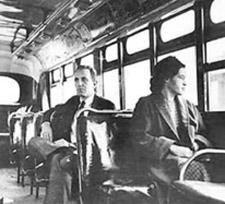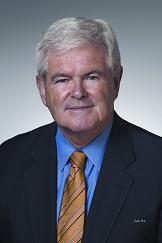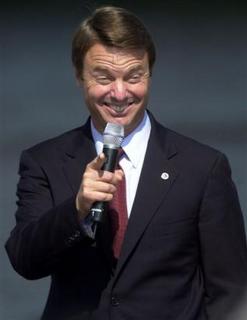Good Night, Good Luck -- and What’s Stephen Colbert Up To, Anyway?

George Clooney’s Good Night, and Good Luck reminds us that some of the best movies come from short stories rather than novels. Not that an actual short story was actually the inspiration of this film about CBS newsman Edward R. Murrow’s courageous battle against the witch-hunting tactics of Senator Joe McCarthy -- but the historical incidents which form the basis of Clooney’s little tale are far better suited to short-story treatment rather than being decked out in the trappings of an epic.
Writer/director Clooney (who also plays Fred Friendly, Murrow’s producer and later the sage convener of some lively and provocative televised seminars on journalism ethics) and co-writer Grant Heslov (who plays staffer Don Hewitt, later 60 Minutes’ producer) center most of the action of the film within the walls of one building, CBS’ Madison Avenue headquarters, over a span of what ultimately shakes out as several weeks during 1953 and 1954. The compressed space and schedule of storytelling within the film, of course, enhance the atmosphere of terror that must have pervaded the hallways of CBS, like many other corridors in America, during the height of McCarthy’s influence – the tension wafts through each pressure-cooked scene like the omnipresent cigarette smoke of each of the film's characters.
Yet the film still has the feel of an old newshound’s reminiscence over the aforementioned cigarettes and a few glasses of scotch – something which emerges from the depiction of the courtly camaraderie among the people in Murrow’s newsroom, and also from Dianne Reeves’ beautiful soundchecks (in which she sings such tunes as “Who’s Minding the Store,” “Straighten Up and Fly Right,” and “You’re Driving Me Crazy”), coming at natural resting spots along the way, commenting on the newsroom behind-the-scenes action with a kind of gleeful yet un-judgmental detachment, not unlike the way real New York reporters of yore might have commented on Washington behind-the-scenes action. She functions, in a way, as the reporter on the reporters.
The performances handily sell Clooney’s vision of the piece – David Strathairn’s Murrow is note for note correct, as dry and determined and alone as one would expect, and Ray Wise, as the pathetic news anchor Don Hollenbeck, manages to embody the pervading fear in his few scenes, smiling so hard it hurts behind eyes peeled back with gulping dread. The only misfire in the cast seems to have come in the form of documentary footage of Joe McCarthy – who, as one of my friends observes, is “just too over-the-top to be believable.”
A number of reviewers have observed that Good Night, and Good Luck’s depiction of the goings-on of a real TV newsroom is unrivalled, although I would submit that while its depiction of a newsroom that produces a show with the intelligence and integrity of Edward R. Murrow’s programs is spot-on, such activity in actuality bears little resemblance to what goes on in today’s TV newsrooms. In fact, it is much more likely that the activity in today’s newsrooms is better suited to turn out the kind of broadcast that Stephen Colbert parodies in his new 4-nights-a-week program, The Colbert Report, on Comedy Central.

While Jon Stewart’s Daily Show (of which Colbert is an alum) parodies a newscast, Colbert is taking on the Alpha-male, self-righteous commentators that take up space between news breaks on cable news networks. But mostly, he’s taking on Bill O’Reilly -- because, let’s face it, O’Reilly’s the ripest of the bunch.
Colbert is a deft and clever writer, and as a performer, he manages to carry off his portrayal of “Stephen Colbert, host” without the slightest wink to his true identity. It’s a fearless approach, a real high-wire act, that makes his show much more akin to the productions of Ali G than of Jon Stewart – and while critics seem to love what’s going on, as quickly as they give praise they wonder if it all can be sustained.
Jon Stewart’s success came as a complete surprise to those who watched him fill the shoes of The Daily Show’s founding “anchor,” Craig Kilborn. In fact, however, it was Kilborn’s stridently detached hipness – all sarcasm, without the mitigating goofiness of Kilborn’s progenitor, David Letterman – that shut down Kilborn after he left The Daily Show. Stewart showed up Kilborn by being a genuinely good-natured human being and by permitting himself to be humiliated from time to time. He is also, unexpectedly to those of us who had our doubts (recalling his ill-fated tenure at MTV), a consummate performer of the old school – a superior mimic, and a take-artist to out-Benny Jack Benny.
So far, Colbert’s real strength comes as an interviewer. In a recent segment with CNN’s Lou Dobbs, Colbert ran roughshod over Dobbs’ pet issues – immigration and outsourcing – by suggesting to him that the U.S. should just outsource all those jobs that those illegals keep coming here for. Even Dobbs had to laugh. Colbert’s schtick -- which combines a singleness of satiric purpose with a disarming (though non-winking) playfulness -- does require otherwise serious people to play along, but when it happens, it is as satisfying as anything on TV these days.
I do not worry so much about Colbert’s ability to keep his on-screen characterization afloat over the long term. I worry more about the defensive humorlessness of those he would hope to book for his show. While Stephen Colbert is having as much fun as anyone should be allowed to have on TV, I can imagine that his booking agent is walking around looking like Ray Wise as Don Hollenbeck in Good Night, and Good News – dodging the post-McCarthyite terror and precious image management that pervades American political TV today.
Labels: Journalism, New Cinema, TV















 MARK TWAIN'S MAP OF PARIS.
MARK TWAIN'S MAP OF PARIS.












